What is a prepositional phrase? To answer that question, you first need to know what a preposition is, so let’s start there.
Preposition Definition
A preposition is the first word of a prepositional phrase. It is a word that connects a noun (a person, place, or thing) or a pronoun (a word that replaces a noun, like me, he, she, they, or it) to the rest of the sentence.
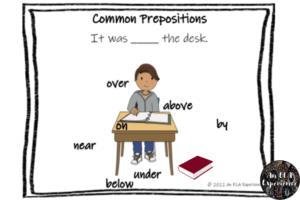
A preposition can often, though not always, fit into this sentence: It was _____ the desk. When teaching, I demonstrate this with a book and a desk. (For example, the book was above the desk, the book was in the desk, the book was beside the desk, etc.) When you do this, you also create prepositional phrases (e.g., above the desk, in the desk, and beside the desk).
Word List of Prepositions
There are over one hundred prepositions. Because there are so many, there isn’t a mnemonic to help students remember them. For this reason, I find it best to provide students with a list of common prepositions. With practice, they will start recognizing them. Notice that most prepositions are short words (with five letters or less) and about half of them will fit into the above test sentence.
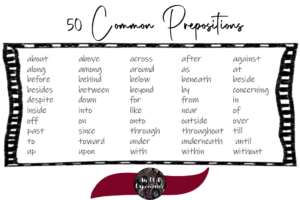
What Are Examples of Prepositional Phrases?
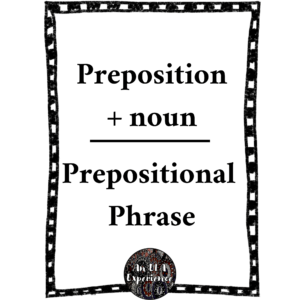
Since a prepositional phrase begins with a preposition and ends with a noun or a pronoun, the easiest way to recognize one is to look for a preposition.
Here are some examples I’ve collected from my reading. Notice they begin with prepositions and end with nouns (and one pronoun).
- of mortality
- in rivers
- along the deck
- to the stern
- into the little town
- in improbable directions
- for bad boys
- in the street
- near the showers
- around him
What Is a Prepositional Phrase?
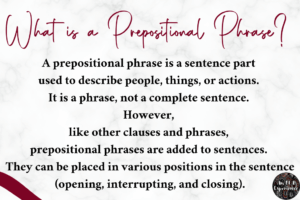
A prepositional phrase is a sentence part used to describe people, things, or actions. It is a phrase, not a complete sentence. However, like other clauses and phrases, prepositional phrases are added to sentences in various positions (opening, interrupting, and closing).
Opening Position
When placed in the opening position, the prepositional phrase comes before the main clause (sentence) as seen in the following example.
In a different world, I think my mother could be beautiful.
Interrupting Position
When used as an interrupter, place the phrase between the subject and the verb.
I, in a different world, think my mother could be beautiful.
Closing Position
When used in the closing position, the prepositional phrase is placed at the end of the sentence after the main clause.
I think my mother could be beautiful, in a different world. ––Veronica Roth, Divergent
In the above example, the prepositional phrase works fairly well in the opening, interrupting, and closing positions of the sentence. However, there will be times when it won’t work in all three positions. As the writer, you decide which way sounds the best.
Roth put the phrase in the closing position and set it off with a comma, which I think is perfectly fitting since the narrator’s mother was in Abnegation, the faction that dresses in gray and hides their beauty. Hence, one little comma speaks volumes.
Prepositional phrases can also be combined. A sentence can include more than one prepositional phrase.
Dark blood flowed in rivers around him. –Alexandra Bracken, Lore
Lore’s sentence closes with two prepositional phrases: in rivers and around him. Notice how the image becomes more descriptive with the addition of prepositional phrases. Readers can now visualize the amount of blood and its location. 😱
More Prepositional Phrases in Sentences
Opening Position
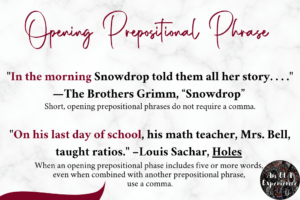
In the morning Snowdrop told them all her story. . . . —The Brothers Grimm, “Snowdrop”
Short, opening prepositional phrases do not require a comma.
On his last day of school, his math teacher, Mrs. Bell, taught ratios. –Louis Sachar, Holes
This sentence opens with two prepositional phrases. When an opening prepositional phase includes five or more words, even when combined, use a comma.
Interrupting Position

The hair on Lore’s body rose. –Alexandra Bracken, Lore
This prepositional phrase is between the subject and the verb, and a comma is not needed. Trust your ears.
Closing Position
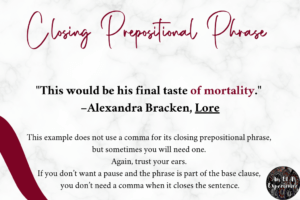
This would be his final taste of mortality. –Alexandra Bracken, Lore
His limbs were twisted in improbable directions. –Ransom Riggs, Miss Peregrine’s Home for Peculiar Children
Unlike the example from Roth mentioned earlier, these two examples do not use commas for their closing prepositional phrases. Again, trust your ears. If you don’t want a pause and the phrases are part of the base clause, you don’t need a comma when they close the sentence.
And More Prepositional Phrases in Sentences–Combos with Openers, Interrupters, and Closers
The man in the cowboy hat spit sunflower seed shells into a wastepaper basket. –Louis Sachar, Holes
This example includes prepositional phrases in the interrupting and closing positions of the sentence. Notice that no commas are needed.
For one horrible moment, Lore was convinced that she was in a lucid dream. –Alexandra Bracken, Lore
Bracken’s sentence includes an opening and closing prepositional phrase. Again, notice that the long opener requires a comma and the closer doesn’t.
The shovels were five feet long, from the tip of the steel blade to the end of the wooden shaft. –Louis Sachar, Holes
This sentence closes with one comma and four prepositional phrases strung together.
Can You End a Sentence with a Preposition?

Yes, you can! I learned this years ago when I was reading On Writing Well by William Zinsser. He writes, “I think a sentence is a fine thing to put a preposition at the end of.” (I love how he ended that sentence with a preposition.) 😍
I’m certain this book is a reliable source, but I was taught to double and even triple-check information, so here’s another. In Brushing Up on Grammar, Joyce Armstrong Caroll and Edward E. Wilson state, “There is also the notion that it is incorrect to end a sentence with a preposition. Nonsense!” They even go on to discuss how this notion came about.
Are Prepositions Capitalized in Titles?
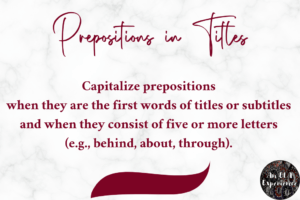
Capitalize prepositions when they are the first words of titles or subtitles and when they consist of five or more letters (e.g., behind, between, through). (Not all style guides adhere to the rule on five or more letters for prepositions, so be sure to check.)
I’m in a fabulous book club that pretty much sticks to murder mysteries, so I’m sharing the ones we’ve read that include prepositional phrases in the titles:
- The Woman in Cabin 10 by Ruth Ware
- Confessions on the 7:45 by Lisa Unger
- Behind Closed Doors by B. A. Paris
- The Woman in the Window by A. J. Finn
- Force of Nature by Jane Harper
- We Are All the Same in the Dark by Julia Heaberlin
- Hour of the Witch by Chris Bohjalian
Of course, the same capitalization rules apply for non-fiction:
- Sentence Composing for Elementary School by Don and Jenny Killgallon (By the way, I used this book for middle school and highly recommend it because it includes explanations and exercises from mentor sentences for adjective clauses, appositive phrases, adverb clauses, participial phrases, prepositional phrases, and more.)
- Patterns of Power: Inviting Adolescent Writers into the Conventions of Language by Jeff Anderson with Travis Leech and Melinda Clark
- Lives of the Writers: Comedies, Tragedies (and What the Neighbors Thought) by Kathleen Krull
If you’re teaching teens, you may prefer these examples:
- Girl in Pieces by Kathleen Glasgow
- If He Had Been with Me by Laura Nowlin
- They Both Die at the End by Adam Silvera
After reading this section, you may notice that prepositional phrases make good titles when used alone, with an added subject, or even in a complete sentence.
Prepositional Phrase Vs. Infinitive Phrase Vs. Adverb Clause
This may be a little more than most want to know, but I’m writing about it for clarification reasons.
If a verb follows the word to, then it’s not a prepositional phrase; it’s an infinitive phrase.
Examples of Infinitive Phrases
At nine o’clock Earth started to explode, to catch fire, and to burn. —Ray Bradbury, The Martian Chronicles
Explode, catch, and burn follow the word to, but since these are verbs and not nouns, they are infinitive phrases.
Examples of Adverb Clauses
Some prepositions are also subordinating conjunctions (e.g., after, as, since, until). Whereas prepositions indicate prepositional phrases, subordinating conjunctions indicate adverb clauses.
To determine whether it’s a prepositional phrase or an adverb clause, remove the first word from the clause or phrase. A prepositional phrase will never have a verb, so when you remove the first word, you will be left with a fragment (an incomplete sentence). An adverb clause is another sentence part, but it includes both a subject and a verb; therefore, when you remove the subordinating conjunction, (the first word from the dependent clause), you will have a complete sentence.
Here’s an example:
As he came nearer, he saw that the two men were his brothers, who had turned robbers. . . . –The Brothers Grimm, “The Golden Bird”
When you omit as from the clause, it is still a complete sentence: He came nearer. For this reason, it’s an adverb clause and not a prepositional phrase.
Lessons on Prepositional Phrases
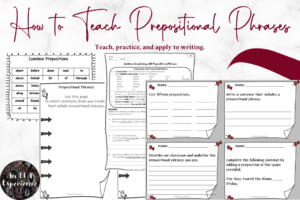
List of Prepositions
Since there are so many prepositions, provide students with a list of ones that are commonly used. This will help students both identify and write them.
Discussing Prepositional Phrases
During discussions, show students the importance of prepositional phrases by asking volunteers to describe something like a room or painting without using prepositional phrases (as Jeff Anderson suggests in Mechanically Inclined, another favorite of mine).
Warm-ups, Worksheets, and Task Cards for Prepositional Phrases
Whether you use task cards or worksheets, you’ll find it helpful to have students work with prepositional phrases in the following ways:
- by combining and imitating mentor sentences (my favorite)
- filling in missing prepositions (good for ESOL learners)
- completing sentence stubs with prepositional phrases
- matching phrases with sentences
- collecting sentences from their reading
Apply New Knowledge to Writing
Most importantly, ask students to apply what they’ve learned to their writing. For example, have them describe your classroom (or another teacher’s) and underline the prepositional phrases. This will not only show them how necessary these phrases are but also how they’re already using them (even though they may not have known what they were called).
Related Links
Worksheets on Prepositional Phrases
What Is a Prepositional Phase? 20 Easy Examples
What Is a Prepositional Phrase? Prepositional Phrase Examples
In a Nutshell, What Is a Prepositional Phrase?
- Prepositional phrases are sentence parts that begin with prepositions and end with nouns or pronouns.
- When first learning about these phrases, use a word list to help you recognize common prepositions.
- Prepositional phrases can be strung together.
- They can also be placed in the opening, interrupting, and closing positions of sentences.
- It’s perfectly okay to end a sentence with a preposition.
- For titles, capitalize prepositions when they are the first words of titles or subtitles and when they have five or more letters.
- When teaching prepositions, give students a list of commonly used prepositions; practice with warm-ups, worksheets, and/or task cards; and provide opportunities to intentionally use them in their writing.
I do hope I answered all of your what-is-a-prepositional-phrase questions!



2 Responses
Thanks again.
Thank you for thanking me with a blog comment (my first blog comment)! 😀